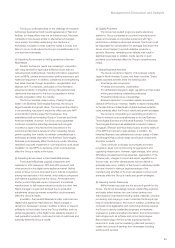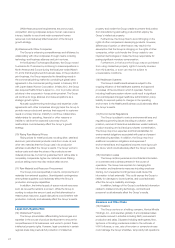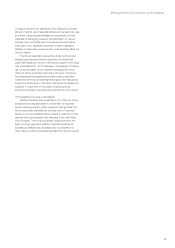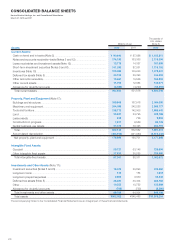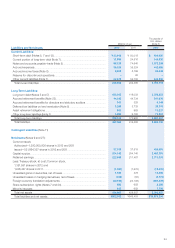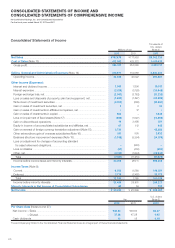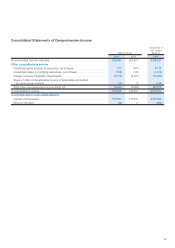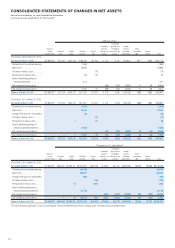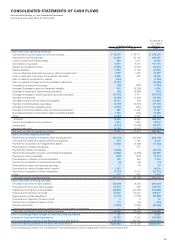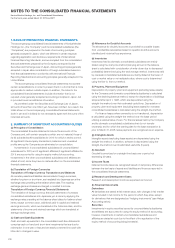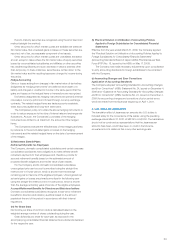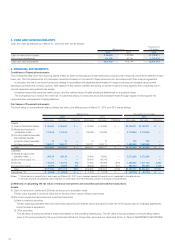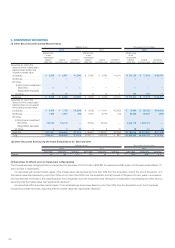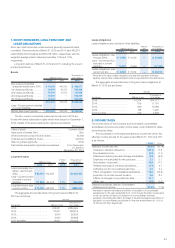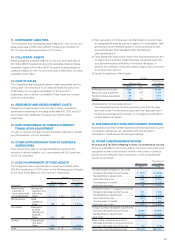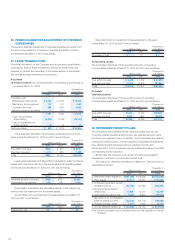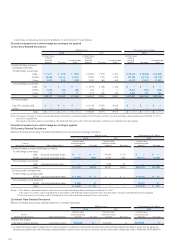Konica Minolta 2012 Annual Report Download - page 30
Download and view the complete annual report
Please find page 30 of the 2012 Konica Minolta annual report below. You can navigate through the pages in the report by either clicking on the pages listed below, or by using the keyword search tool below to find specific information within the annual report.29
NOTES TO THE CONSOLIDATED FINANCIAL STATEMENTS
Konica Minolta Holdings, Inc. and Consolidated Subsidiaries
For the scal years ended March 31, 2012 and 2011
1. BASIS OF PRESENTING FINANCIAL STATEMENTS
The accompanying consolidated fi nancial statements of Konica Minolta
Holdings, Inc., (the “Company”) and its consolidated subsidiaries (the
“Companies”) are prepared on the basis of accounting principles
generally accepted in Japan, which are different in certain respects
regarding application and disclosure requirements of International
Financial Reporting Standards, and are compiled from the consolidated
fi nancial statements prepared by the Company as required by the
Securities and Exchange Law of Japan. Accounting principles generally
accepted in Japan allow consolidation of foreign subsidiaries based on
their fi nancial statements in conformity with International Financial
Reporting Standards and accounting principles generally accepted in the
United States.
The accompanying consolidated fi nancial statements incorporate
certain reclassifi cations in order to present them in a format that is more
appropriate to readers outside Japan. In addition, the notes to the
consolidated fi nancial statements include information that is not
required under generally accepted accounting principles in Japan, but
is provided herein as additional information.
As permitted under the Securities and Exchange Law of Japan,
amounts of less than one million yen have been omitted. As a result, the
totals shown in the accompanying consolidated fi nancial statements
(both in yen and in dollars) do not necessarily agree with the sums of the
individual amounts.
2. SUMMARY OF SIGNIFICANT ACCOUNTING POLICIES
(a) Principles of Consolidation
The consolidated fi nancial statements include the accounts of the
Company and, with certain exceptions which are not material, those of
its 92 subsidiaries (89 subsidiaries for 2011) for which it retains control.
All signifi cant intercompany transactions, balances and unrealized
profi ts among the Companies are eliminated on consolidation.
Investments in 3 unconsolidated subsidiaries (3 unconsolidated
subsidiaries for 2011) and 2 signifi cant affi liates (2 signifi cant affi liates for
2011) are accounted for using the equity method of accounting.
Investments in the other unconsolidated subsidiaries and affi liates are
stated at cost, since they have no material effect on the consolidated
fi nancial statements.
(b) Translation of Foreign Currencies
Translation of Foreign Currency Transactions and Balances
All monetary assets and liabilities denominated in foreign currencies,
whether long-term or short-term, are translated into Japanese yen at the
exchange rates prevailing at the balance sheet date. The resulting
exchange gains and losses are charged or credited to income.
Translation of Foreign Currency Financial Statements
The translation of foreign currency fi nancial statements of overseas
consolidated subsidiaries into Japanese yen is done by applying the
exchange rates prevailing at the balance sheet dates for balance sheet
items, except common stock, additional paid-in capital and retained
earnings accounts, which are translated at the historical rates, and the
statements of income and retained earnings which are translated at
average exchange rates.
(c) Cash and Cash Equivalents
Cash and cash equivalents in the consolidated cash fl ow statements
comprise cash on hand and short-term investments that are due for
redemption in one year or less and are easily converted into cash with
little risk to changes in value.
(d) Allowance for Doubtful Accounts
The allowance for doubtful accounts is provided for possible losses
from uncollectible receivables based on specifi c doubtful accounts
identifi ed and historical loss experience.
(e) Inventories
Inventories held by domestic consolidated subsidiaries are mainly
stated using the cost price method (carrying amount in the balance
sheet is calculated with consideration of write-down due to decreased
profi tability) determined using the total average method. Inventories held
by overseas consolidated subsidiaries are mainly stated at the lower of
cost or market value or net realizable value, where cost is determined
using the fi rst-in, fi rst-out method.
(f) Property, Plant and Equipment
Depreciation of property, plant and equipment (excluding lease assets)
for the Company and domestic consolidated subsidiaries is calculated
using the declining balance method, except for depreciation of buildings
acquired after April 1, 1998, which are depreciated using the
straight-line method over their estimated useful lives. Depreciation of
property, plant and equipment (excluding lease assets) for overseas
consolidated subsidiaries is calculated using the straight-line method.
For fi nance leases where ownership is not transferred, depreciation
is calculated using the straight-line method over the lease period
utilizing a residual value of zero. For fi nance leases held by the Company
and its domestic consolidated subsidiaries that do not transfer
ownership and for which the starting date for the lease transaction is
prior to March 31, 2008, lease payments are recognized as an expense.
(g) Intangible Assets
Intangible assets (excluding lease assets) are depreciated using the
straight-line method. In addition, software is depreciated using the
straight-line method over its estimated useful life (5 years).
(h) Goodwill
Goodwill is amortized on a straight-line basis over a period not
exceeding 20 years.
(i) Income Taxes
Deferred income taxes are recognized based on temporary differences
between the tax basis of assets and liabilities and those as reported in
the consolidated fi nancial statements.
(j) Research and Development Costs
Research and development costs are expensed as incurred.
(k) Financial Instruments
Derivatives
All derivatives are stated at fair market value, with changes in fair market
value included in net income for the period in which they arise, except
for derivatives that are designated as “hedging instruments” (see Hedge
Accounting below).
Securities
Investments in equity securities issued by unconsolidated subsidiaries
and affi liates are accounted for using the equity method of accounting;
however, investments in certain unconsolidated subsidiaries and
affi liates are stated at cost due to the effect of the application of the
equity method of accounting being immaterial.



